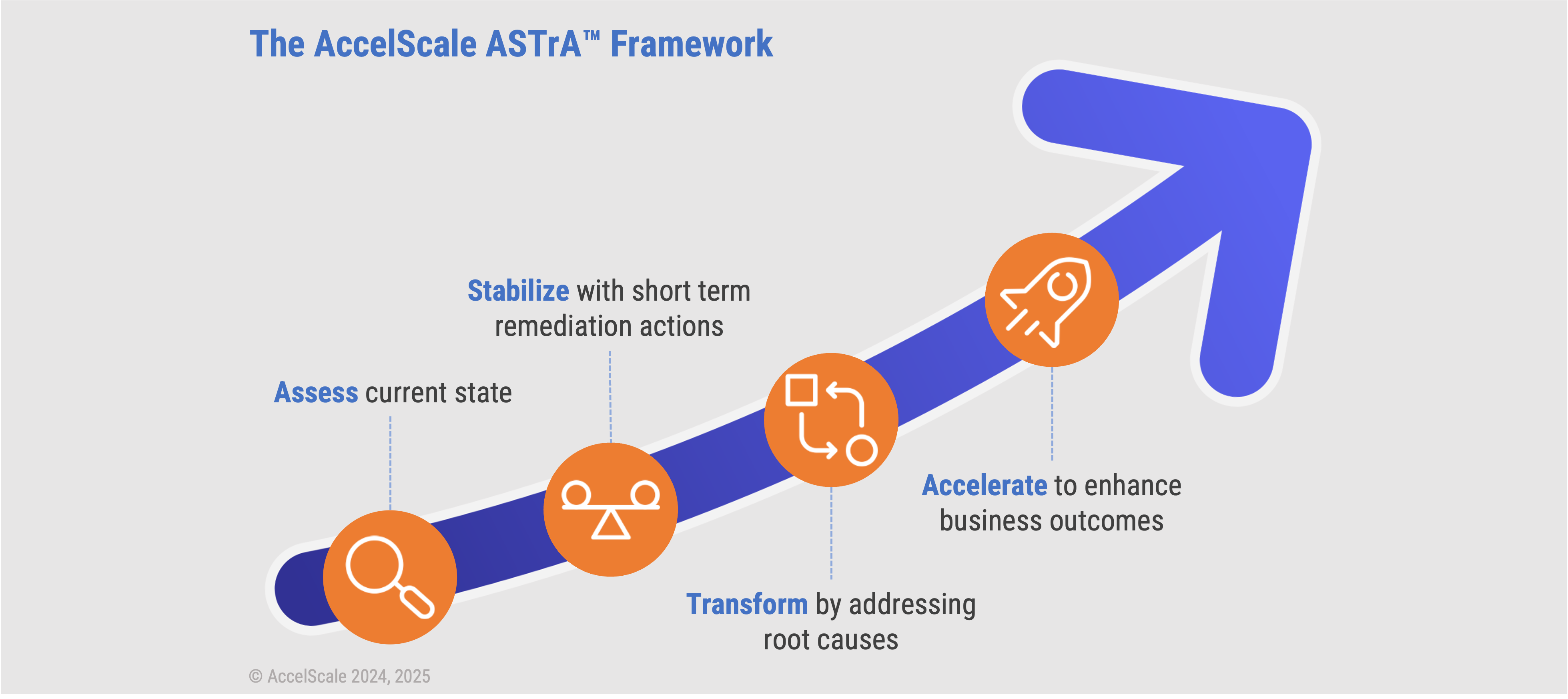Turning Around Troubled IT Projects – A Guide for IT Executives
03 February 2025
Here’s a question if you’re a senior IT executive – How often have you seen projects run into trouble during your career? The answer is probably more often than you’d like. Whether in-house or outsourced, IT projects have a tendency to go off the rails, resulting in missed deadlines, budget overruns, quality issues, functionality gaps etc.
In an attempt to recover from these situations, IT managers often resort to broad measures like changing project leadership or just throwing more resources at the project. We believe a structured approach is a better option which not only helps turnaround such projects, but creates a path for lasting success. We share an outline of an internally developed framework called ASTrA™, that we use to help our clients turnaround and get challenged IT projects back on track.
1. Assess
Before you can fix a project, you need to understand what’s broken and how bad the damage is. A structured, multi-dimensional project assessment is required to gain a clear, unbiased picture of the problems and their root causes. Ideally, this should be led by an external consultant or an experienced assessor who is not directly involved with the project.
Transparency is key. Management needs to foster an environment of honest inquiry with the project team to ensure issues aren’t overlooked or sugar-coated. A thorough assessment will uncover the major challenges and contributing factors impacting the project’s objectives.
2. Stabilize
Project issues typically fall into three categories: People, Process, and Technology. The assessment phase will likely identify multiple problems across these areas, but not all of them can be addressed at once. Focus on a few critical, high-impact fixes to stabilize the project. For e.g., this might include:
- Addressing weakness in leadership or critical roles.
- Fixing a broken or disregarded quality process.
- Improving communication between client and project teams.
Set clear and realistic turnaround objectives within the constraints of time and budget. Align these objectives with stakeholders and, if necessary, negotiate adjustments to scope and timelines with the client or business sponsor. This will likely involve difficult conversations with stakeholders, but it’s unavoidable. Do not overcommit. The goal here is not to focus on delivering all of the original objectives of the project, but to get the project moving in the right direction again.
3. Transform
Once the project is stabilized and moving in the right direction, shift your focus to long-term success. Tackle the remaining issues across People, Process, and Technology to fundamentally transform how the project team operates.
Key actions can include:
- Assigning the right people to the project based on thorough skills assessment.
- Restructuring roles or adding necessary expertise to strengthen the team.
- Strengthening processes, including client-side activities like scope definition.
- Resolving tooling or technology gaps that impact performance.
- Providing necessary training and skills development to build team expertise.
The goal of this stage is to create a foundation for sustained project success.
4. Accelerate
With a stabilized foundation and transformed operations, the project team should be ready to accelerate performance and throughput. The focus now shifts to achieving high levels of execution and delivering results at the pace expected of a high-performing team.
Sustaining the Turnaround
Turning around a troubled project is a significant accomplishment and should be celebrated with the team. However, the work doesn’t stop there. Ongoing vigilance is essential to ensure the project stays on track. One of the most effective ways to sustain success is by conducting periodic project risk assessments. This approach identifies emerging risks and provides early warning of potential problems, giving management and stakeholders the opportunity to address them before they escalate into major issues.
A structured approach such as the ASTrA™ framework helps IT executives not only rescue projects in distress but also establish practices that prevent future setbacks. Remember: turning a project around is not merely about resolving immediate issues; it’s about establishing a sustainable foundation for future success.
For more information on how we can help you turnaround your IT projects using our ASTRA™ framework, reach out to us at contact@accelscale.in

